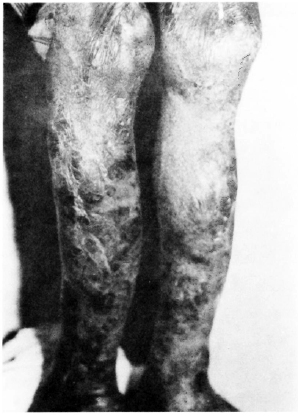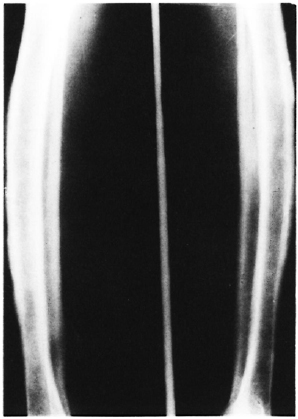- Volume 58 , Number 2
- Page: 385–7
Saber tibiae in lepromatous leprosy
To the Editor:
A case of bilateral " saber tibiae" deformity that developed following recurrent episodes of type 2 lepra reaction is reported.
A 48-year-old male was diagnosed to have lepromatous leprosy in 1980, based on clinical, histopathological, and bacteriological features. He was treated with dapsone monotherapy which he discontinued after 1 year. For the last 5 years he has had recurrent episodes of multiple, painful and tender, transient, cutaneous nodules on the trunk and limbs and painful soft swellings on the front of both tibiae associated with fever and other constitutional symptoms. The cutaneous nodules used to resolve in 7-10 days, leaving bluish discoloration, although some of them ulcerated and healed slowly leaving scars, especially on the legs and forearms. The swellings on the tibiae last for 3-4 weeks and leave residual thickening of the front of the affected bones. The various analgesics and antipyretics he had been taking gave only transient relief of the signs and symptoms. For the last 4 years, he has noticed a gradual anterior bowing in the middle part of both legs. There was no history of genital ulcer, and he denied any history of extramarital sexual exposure.
Examination revealed multiple, shiny, infiltrated macules, plaques and nodules distributed bilaterally and symmetrically on the face, pinna of the ears, trunk and limbs. A few erythematous, warm, tender cutaneous nodules (1 to 2 cm in size) also were seen on the front of the legs, forearms and face. There was a " glove-and-stocking" type of anesthesia on the limbs. The lateral popliteal nerves on both sides were diffusely enlarged and slightly tender. The skin as a whole was dry and ichthyotic over the limbs and buttocks. Numerous areas of scarring were seen on the legs and forearms. There was irregular thickening, widening and anterior bowing of the middle third of the anterior surface of shaft of both tibiae, resulting in saber-shin deformity (Fig. 1). The teeth, eyes and nose were normal. All other systems were clinically normal.

Fig. 1. Saber-shin deformity in a patient with lepromatous leprosy with recurrent type 2 lepra reaction. Note bowing of anterior curvature of both legs.
Routine laboratory tests on blood, urine, and stools were normal except for an increase in ESR (42 mm/first hour, Weste-gren). Blood VDRL and Treponema pallidum hemagglutination (TPHA) tests for syphilis were negative. Slit-skin smears from different sites including the legs showed numerous acid-fact bacilli, a bacterial index of 6+ (Ridley-Jopling scale), and a morphological index of 24%. Histopathological studies were made of a nodule on the face, revealing features of lepromatous leprosy, and of a tender nodule on the leg, showing features of erythema nodosum leprosum. An X-ray of the legs revealed thickening of the periosteum with subperiosteal bone formation and diffuse cortical thickening, especially of the anterior third of both tibiae. This resulted in bowing of the anterior curvature of both tibiae (Fig. 2). There was no clinical or laboratory evidence of syphilis in his wife, mother, siblings or children. For 6 months the patient has been on multidrug therapy with dapsone, rifampin and clofazimine as recommended by WHO.

Fig. 2. X-ray of the leg bones. Note subperiosteal bone formation and diffuse thickening of the cortex, especially of the middle third of the shaft of tibia, resulting in " saber tibia."
Saber-shin deformity characterized by thickening and anterior bowing of the middle third of the shaft of the tibia is one of the stigmas of heredosyphilis, and it also results from osteitis and ossifying periostitis during the early months of life. It may rarely occur in yaws and in acquired syphilis also. Our patient had no clinical or laboratory evidence of congenital or acquired syphilis. Severe bone pain, particularly of the tibia, due to osteoperiostitis, is common during type 2 lepra reaction. Our patient had recurrent episodes of type 2 lepra reaction, and had the associated signs and symptoms of osteoperiostitis of the tibiae. Each attack of osteoperiostitis eventually subsides with the laying down of new bone. Repeated attacks result in further deposits of new bone and in thickening of the cortex of the bone leading to increased anterior curvature of the bone, resulting in a deformity reminiscent of the " saber tibia" of syphilis (2). Although different types of deformities of the bones have been described in leprosy, " saber tibia" is rarely reported (1). This report emphasizes the need for considering leprosy also in the differential diagnoses of " saber tibia."
- K. Pavithran, M.D., D.V.D.
Associate Professor
Department of Skin and VD
Medical College Hospital
Kottayam 686008, India
REFERENCES
1. Girdhar. M., Arora. S. K., Mohan, L., Gupta. M. and Mukhija. R. D. An unusual case of sabre tibia. Indian J. Sex. Transmit. Dis. 10(1989)37-39.
2. Ramu, G. and Dharmendra. Acute exacerbations (reactions) in leprosy. In: Leprosy. Volume I. Dharmendra, ed. Bombay: Kothari Medical Publishing House. 1978, p. 128.